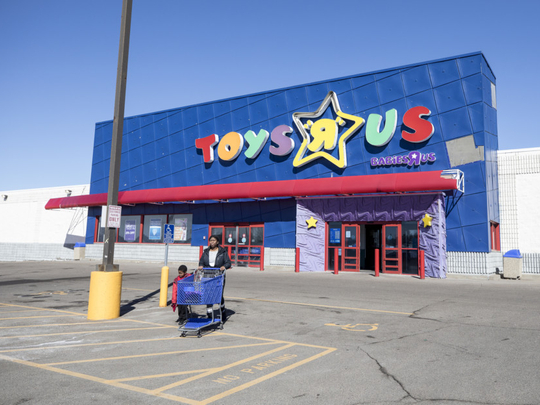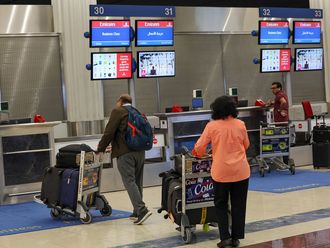
The mood in the courtroom was hopeful when Toys R Us filed for bankruptcy last September.
The company’s lawyer, in the first hearing, played a clip of the retailer’s famous jingle “I’m a Toys R Us Kid” and vowed to restore the company’s place in the hearts of millions of American families. The reality is that Toys R Us, which announced last week that it would shutter or sell all of its stores in the US, never had much chance at a turnaround. For more than a decade, Toys R Us had been drowning in $5 billion of debt, which its private equity backers had saddled it with.
With debt payments siphoning off cash every year, Toys R Us could not properly invest in its worn-out suburban stores or outdated website. Sales plummeted, as Amazon captured more children’s desires — and their parents’ wallets — for Star Wars Legos and Paw Patrol recycling trucks. Toys R Us is the latest failure of financial engineering, albeit one that could portend a potentially more ominous outlook for private equity in the digital era.
Most buyouts tend to work the same way. A private equity firm takes over a troubled company with the goal of sprucing up the strategy, cutting costs and overhauling the business over three to five years. But they often load up a company with debt to pay for the deal, which can prove problematic if the profits do not perk up.
In the age of Amazon, that formula can be dangerous. Consumer demands are changing so quickly that heavily indebted companies have trouble reordering their business to adapt and compete with better-funded rivals. A wave of buyouts has collapsed in recent weeks felled by digital competition.
Struggling in the streaming music age, iHeartMedia, the large radio company saddled with debt since its 2008 buyout, filed for bankruptcy. The New York grocery chain Tops filed for bankruptcy last month, citing competition from Amazon and the debt burden its former private equity backers had heaped on it. Other buyouts are looking shaky.
The television company Univision, which recently scrapped plans for a public offering, is shaking up its leadership. The parent company of the Winn-Dixie supermarket chain said it was seeking to restructure its debt, as it planned to close stores.
Not all troubled private equity deals end with a company winding down, as in the case of Toys R Us. Retailers like Gymboree and Payless ShoeSource have found second lives after emerging from bankruptcy, often with investments from new private equity or hedge fund owners willing to give the business another try. But the deterioration of Toys R Us from a potential turnaround strategy to the end of an iconic brand — in a matter of months — shows just how difficult it can be for private equity to compete in a rapidly evolving industry.
In retailing, Amazon is reordering everything on the store shelf. And children’s changing interest in games and toys, which now encompasses high-end electronics, adds to the complexity. Toys R Us said t had no other option than to begin winding down about 730 stores around the US. It was still looking at the possibility of keeping 200 stores open and combining them with its Canadian operations.
But no deal had been struck yet. “This is a profoundly sad day for us,” the Toys R Us chief executive, David Brandon, said, “as well as for the millions of kids and families who we have served for the past 70 years.”
The toy business looked a lot simpler in 2005, when the private equity firms Bain Capital and Kohlberg Kravis Roberts and the real estate firm Vornado Realty Trust acquired the company for $6.6 billion. The investor group figured the toy industry was ripe for consolidation. After the buyout, Toys R Us bought the famed toy seller FAO Schwarz as well as the brand and website of KB Toys.
The company had become the world’s largest “toy showroom”, its shelves stocked with thousands of action figures, video games and other wares from large suppliers like Mattel and Hasbro as well as smaller brands that make stuffed animals and glow-in-the-dark slime. Sales were strong, even after the recession.
The company had considered going public, giving its private equity owners a way to cash out. But the company scrapped the offering in 2013, citing unfavourable market conditions. Enter Amazon.
In recent years, the company had started to aggressively expand its toy business, creating a comprehensive, online showroom with low prices at the click of a button. Pressed by Amazon, Walmart also pushed hard into toys, dropping its prices to capture more market share. Walmart could absorb the price cuts on toys because it makes up the profit on other items.
But for Toys R Us, a price war on toys and games, its only offerings, was devastating. In 2015, the company hired Brandon as chief executive. The former head of the University of Michigan’s athletic department, he helped turn around Domino’s Pizza, another private equity investment.
But he lacked extensive experience in the toy industry. By the time he joined Toys R Us, the company faced a conundrum. After a lack of investment, its stores were in need of a serious overhaul.
Many American customers complained about its sprawling spaces and tired displays. But it was unclear whether those investments would pay off when parents were shopping increasingly on their laptops and smartphones. Money, too, was tight.
Most of its debt, totalling about $5 billion, had not been paid down since the buyout 12 years earlier. It was paying $400 million in interest payments each year. “This company had a long history of taking on debt and kicking the can down the road for 10 years, and refinancing,” said Douglas M. Foley, a lawyer at McGuireWoods.
With sales falling and debt payments mounting, the company’s lawyer said in September that Toys R Us had “too much debt”. It filed for Chapter 11 bankruptcy protection, seeking to shed some of its debt and reorganise its business.
The company secured new loans to keep operating into the critical holiday selling season and said it would hire hundreds of seasonal workers to help improve customer service. But the holidays were a bust for Toys R Us, even as other retailers reported strong sales.
The company said that its earnings during the shopping season were $250 million less than expected. The lenders, which had given the company considerable leeway during the holidays, lost confidence in the turnaround plan.
“The business plan was underwhelming, that is best way to say it,” Foley said. The company has been haemorrhaging money.
Foley calculated that company had spent nearly $50 million on legal, banking and consulting fees from September through January. The lenders determined that they needed to stop burning through cash and start selling off the company’s inventory and real estate.
The company said that it talked to several possible buyers of its US operations. But it could not complete a sale, leading to its demise.
“The retail industry is going through such a convulsion, it is not clear what the end of the road looks like,” said Stephen B. Selbst, a bankruptcy lawyer at Herrick Feinstein. “If you are an equity investor, you probably think ‘you know what? I have other uses for my money.”
— New York Times News Service












